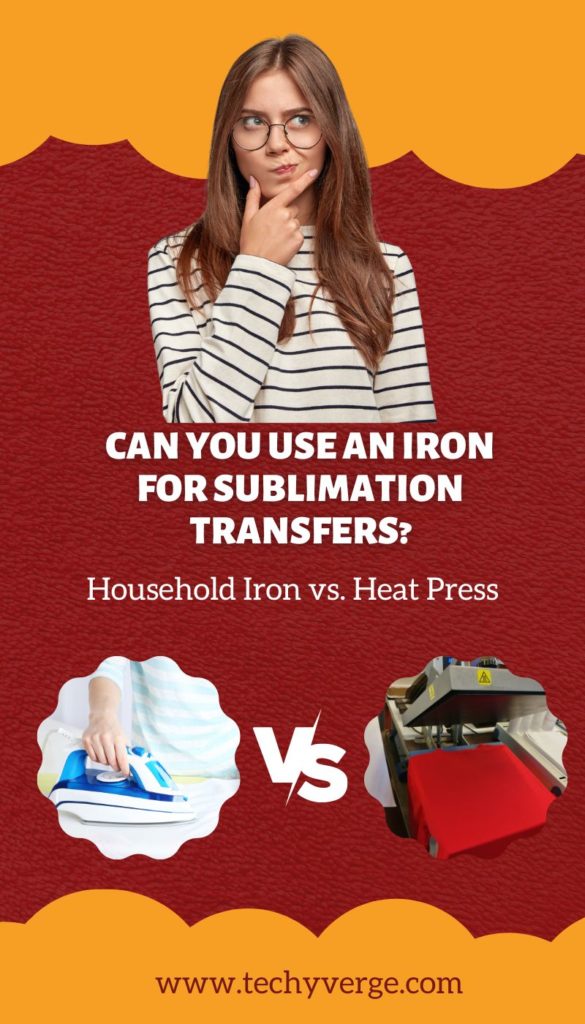Can you use iron for sublimation transfers? The answer is No; the sublimation transfer process requires firm and flat pressure for at least 60 seconds.
This is necessary to avoid blurry results as it must stay perfectly still during this period, or you will end up with an unclear image on your garment!
Even if you could manage movements around small items like these shirts here – which are about 3 inches across-the steam divots from most household irons make them unprintable without going overboard into seeing spots instead of fabric(which isn’t possible anyway).
Recommended for You:
We will tell you what can be sublimated using a regular iron. And give you some methods on how to achieve the best results.
Have People Tried Using an Iron for Sublimation?
Many people have attempted to use a regular household iron for sublimation transfers with varied results. Some have had decent results, while others have not been quite as successful.
The biggest challenge when using an iron is that you need to apply firm and flat pressure for at least 60 seconds to achieve the best results. If you cannot apply pressure evenly for the entire time, you will end up with a blurry image on your garment.

In addition, most household irons produce steam which can cause the image to become distorted or blurry.
What Can Be Sublimated Using a Regular Iron?
With a regular household iron, you can sublimate tiny objects such as t-shirts quickly and easily.
Cotton is the best material for this task because it doesn’t leave behind any residue or alterations when removed from an article of clothing after processing with heat sources like irons do in some cases (depending on how much moisture there is).
A few items can be successfully sublimated using a regular iron. These items typically include small, flat objects such as patches, keychains, mugs, and phone cases.
One of the best methods for using a regular iron for sublimation is to use a heat-resistant sheet or pillowcase. This will help to protect the image from becoming distorted or blurry.
Another method is to use a pressing cloth. This is a thin piece of fabric that can be placed between the image and the garment. This will help to ensure that the image does not become distorted or blurry.
Which Material Is Needed To Sublimate A T-Shirt?
- Sublimation Printer
- Household Iron
- Protective paper
- Heat resistant tape
- Protective mat
Household Iron Types
There are two types of household irons-steam and dry. Steam irons produce steam while the fabric is being pressed. This can help to remove wrinkles and creases from the fabric. Dry irons do not produce steam.
When using an iron for sublimation transfers, it is best to use a dry iron. This is because steam can cause the image to become distorted or blurry.
In addition, it is important to use an iron that has a good weight to it.
This will help to ensure that the pressure is even and that the image does not become blurry.
Some of the best irons for sublimation transfers include the Rowenta DW5080 Focus Steam Iron, the Black & Decker D2030 Digital Advantage Professional Steam Iron, and the Sunbeam GCSBTS-100-000 Ceramic Soleplate Steam Iron.
These irons have a good weight and produce dry heat, which is needed for sublimation transfers.
Supplies for Iron Sublimation
What type of iron?
A regular household iron will work for small, flat objects. For items like t-shirts, you will need a heat press.
What type of paper?
You can use any paper for sublimation transfers, but it is best to use a paper designed for this purpose. A few different types of sublimation paper are available, including transfer paper, photo paper, and fabric sheets.
Is Sublimation Ink Used?
Sublimation ink is not used when transferring images with a regular household iron. Instead, the image is transferred to the fabric using heat and pressure.
Tips for Using an Iron for Sublimation
- Ensure that the iron is clean and free of any lint or dirt before use. This will help to ensure a good transfer.
- If possible, test the transfer on a scrap piece of fabric or paper before transferring it to the actual article of clothing. This will help to ensure that the image is placed in the correct location and that the colors are correct.
- Use a good quality paper designed for sublimation transfers. This will help to ensure a good-quality image.
- Preheat the fabric for a few seconds before transferring the image. This will help to ensure that the image does not become distorted or blurry.
- Apply pressure evenly for at least 60 seconds. This is necessary to ensure a good-quality image.
- Allow the fabric to cool completely before removing the transfer. If the transfer is removed while still hot, it may peel or fade.
- Do not use steam when transferring an image with a regular household iron. Steam can cause the image to become distorted or blurry.
How To Apply Sublimation Transfers With Iron?
- Prepare the substrate by preheating it for a few seconds using an iron. Do not use steam.
- Place the image face down on the substrate.
- Iron with medium to heavy pressure for 60 seconds. Make sure to apply pressure evenly.
- Allow the substrate to cool completely before removing the image. If removed while still hot, the image may peel or fade.
- Enjoy your new sublimated garment!
You should know that a small item can be sublimated with a household iron. The heat press is the best option for next-level sublimation printing.
Selecting Heat Press for Home Use
When selecting a heat press for home use, consider a few things like plate size and volts.
The first is the size of the heat press. Some heat presses are small enough to fit t-shirts and mugs. If you need to transfer images to larger items, like clothing or sheets, you will need a larger heat press.
The second is the type of heat press. There are two types of heat presses – manual and digital. A digital heat press will give you more control over the temperature and time, while a manual heat press requires more guesswork.
Finally, consider the price and quality of the heat press. Some heat presses are priced very low but are made with lower-quality materials. It is important to find a heat press that is affordable and reliable.
FAQ’s
While you can use an iron for sublimation transfers, it is not recommended. A regular household iron does not provide the same level of heat or pressure as a heat press, resulting in a poor-quality image.
No, iron-on transfer paper is not the same as sublimation paper. Sublimation paper is designed specifically for sublimation transfers, while iron-on transfer paper can be used for various purposes, including transfers and stickers.
Final Words
A regular household iron can be used for sublimation transfers, but it is not recommended.
To summarize, if you plan on sublimating anything larger than a dog tag, then get yourself some real-life heat output and make sure that your press can handle the task at hand! An iron might work for small items, but it’s not safe or intended for use.
- Can You Sublimate on Nylon and Polyester? Which oneis the Best - February 19, 2024
- Converted Epson Eco Tank Et-2800 Vs Et-2803 Sublimation Printer [Review 2024] - February 19, 2024
- Can You Reuse Sublimation Prints? (The Righ Answer) - February 19, 2024


![Top 100+ FAQs Related to Sublimation Printing & Heat Press [Updated 2024] faqs related to sublimation Printing](https://www.techyverge.com/wp-content/uploads/2022/08/faqs-related-to-sublimation-Printing--150x150.jpg)



